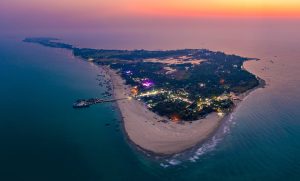This February, I went on a three day vacation with my friends to Saint Martin’s Island, an 8-square-kilometer island in the Bay of Bengal, Bangladesh. The island is also known as Narikel Jinjira (Coconut Island) or Daruchini Dwip (Cinnamon Island).
It was around 9:00 a.m. on February 14. I had just woken up. Soon after, I heard a booming sound mingling with the melody of the saltwater waves. Five minutes later, the sound came again – this time three consecutive blasts.
At our resort, I overheard some people talking. “I’ve been hearing that sound since early morning,” one said. “Locals say it’s the sound of bombing and firing between the resistance group and the Myanmar Army.”
Although Saint Martin’s Island is under Bangladesh’s jurisdiction, it is only eight kilometers from the Myanmar coast. The island’s southern and western parts are bordered by an endless expanse of the Bay of Bengal, while the northern coast faces mainland Bangladesh. The island is around nine kilometers away from Teknaf, a subdistrict in Cox’s Bazar District.
To Saint Martin’s east lies Myanmar’s Rakhine State, which has recently been the site of fierce fighting between the Myanmar military and the Arakan Army, one of many ethnic armed organizations (EAOs) that has joined the resistance against the junta.
Now the conflict between the resistance group and the junta has reached the doorstep of the island. On June 5, a boat carrying election equipment and officials was fired upon from Myanmar’s territory as it returned from the island. Luckily, no one was shot.
The situation became worse on June 8, when gunfire halted a cargo vessel traveling from Teknaf to Saint Martin’s. As a result the local administration suspended travel on this route, leaving over 10,000 residents of the island facing a severe shortage of daily necessities, including food.
On June 11, an unidentified armed group from Myanmar fired upon an island-bound speed boat along the Naf River. Moreover, warships belonging to Myanmar are now visible from Saint Martin’s.
These continued incidents have effectively cut off the island from the mainland, deepening the residents’ state of isolation.
“Although now I spend most of the time in Dhaka, the capital, around 537 kilometers away from Saint Martin’s Island, I was born and raised here. And now I come home usually every two or three months. I have never seen such a situation before,” Nur, 26, told The Diplomat by phone on June 14.
“A food crisis has already started as no cargo boats and speedboats are running to the area,” Nur added. After nine days, “a ship arrived with food and other daily essentials” given by the Cox’s Bazar district administration. “However, if the boats don’t start running again normally the crisis won’t be solved,” he said.
Moreover, the island has only one small government hospital. If someone needs better treatment they must go to Teknaf or Cox’s Bazar. Therefore, if the lack of transportation to and from the mainland persists, there is a possibility of people dying without proper treatment.
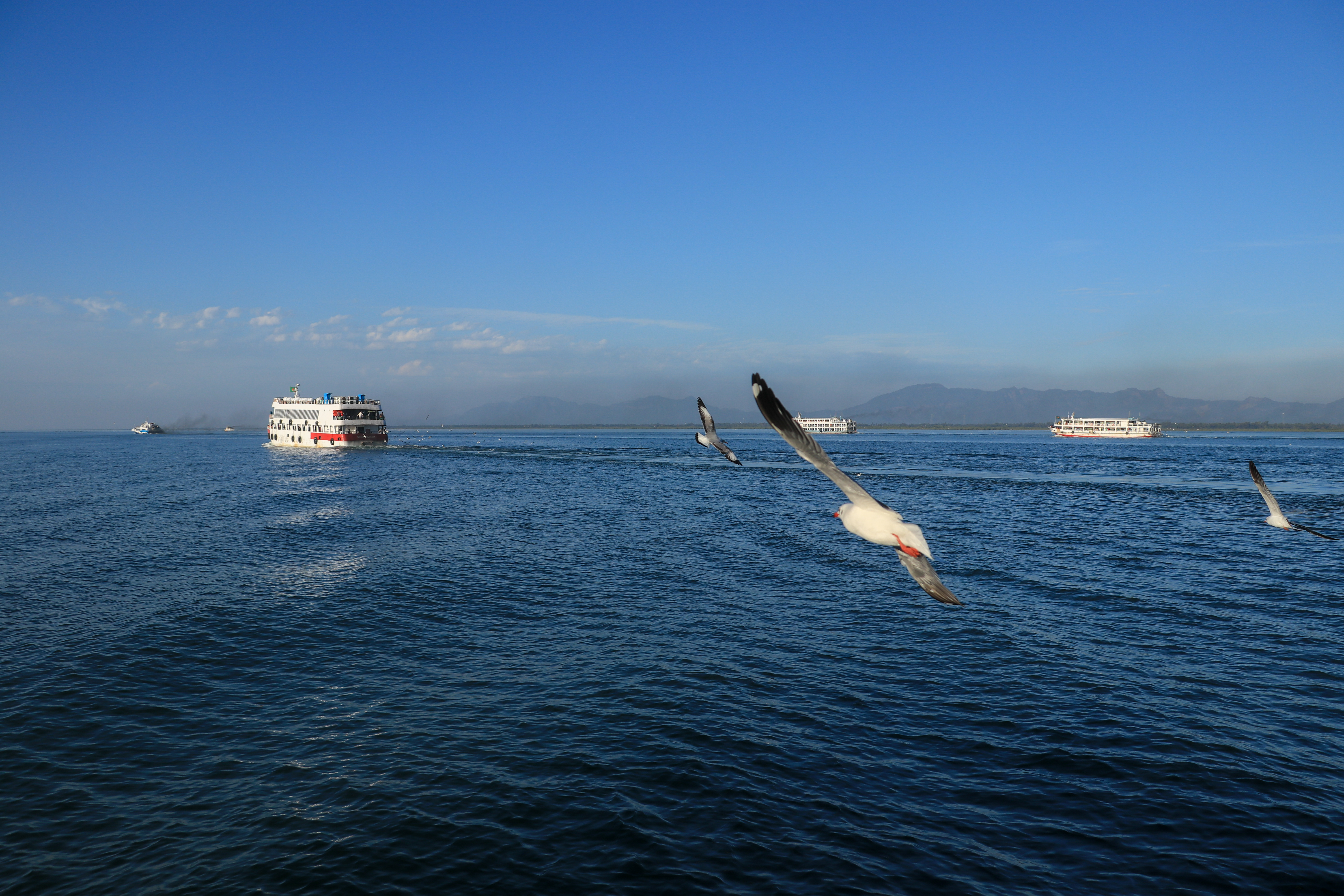
Tourist vessels return to Teknaf through the Naf River in January 2022. The hills of Myanmar are also visible on the horizon. Photo by Saqlain Rizve.
On October 27, 2023, fighting between the Myanmar junta and resistance forces in the north – including Rakhine State – intensified dramatically as an alliance of three EAOs launched an offensive known as Operation 1027. The Three Brotherhood alliance – made up of the Arakan Army (AA), Ta’ang National Liberation Army, and Myanmar National Democratic Alliance Army – launched coordinated attacks on military positions across northern Myanmar. This operation was reported to have caused many casualties and posed a new challenge to the generals who seized power in February 2021.
The resistance struggle has been characterized by a mix of conventional and guerrilla warfare tactics, and resistance groups have made significant gains against the junta in recent months. Since October 27, the fighting has come ever closer to the 271-kilometer Bangladesh-Myanmar border.
On February 6 of this year, it was reported that 264 Myanmar Border Guard Police (BGP) personnel had entered Bangladesh, including some with critical injuries who were being treated at local hospitals. Since then, more than 1,000 BGP personnel have reportedly fled to Bangladesh. On June 13, at least 28 defeated Myanmar junta troops fled across the border to Bangladesh amid ongoing conflict with the AA in northern Rakhine State.
The repeated incursions by fleeing troops from Myanmar is part of a pattern that has seen southeastern Bangladesh subjected to persistent attacks, including gunfire, mortar attacks, and even gunship strikes from Myanmar forces. The Chittagong Hill Tracts, a heavily militarized and ethnically diverse region, faces heightened tensions as a result of these developments.
The situation is particularly worrisome for Saint Martin’s Island, as every year from October to March the island opens for tourists. During the peak period, locals estimate that 5,000-8,000 tourists visit Saint Martin’s every day.
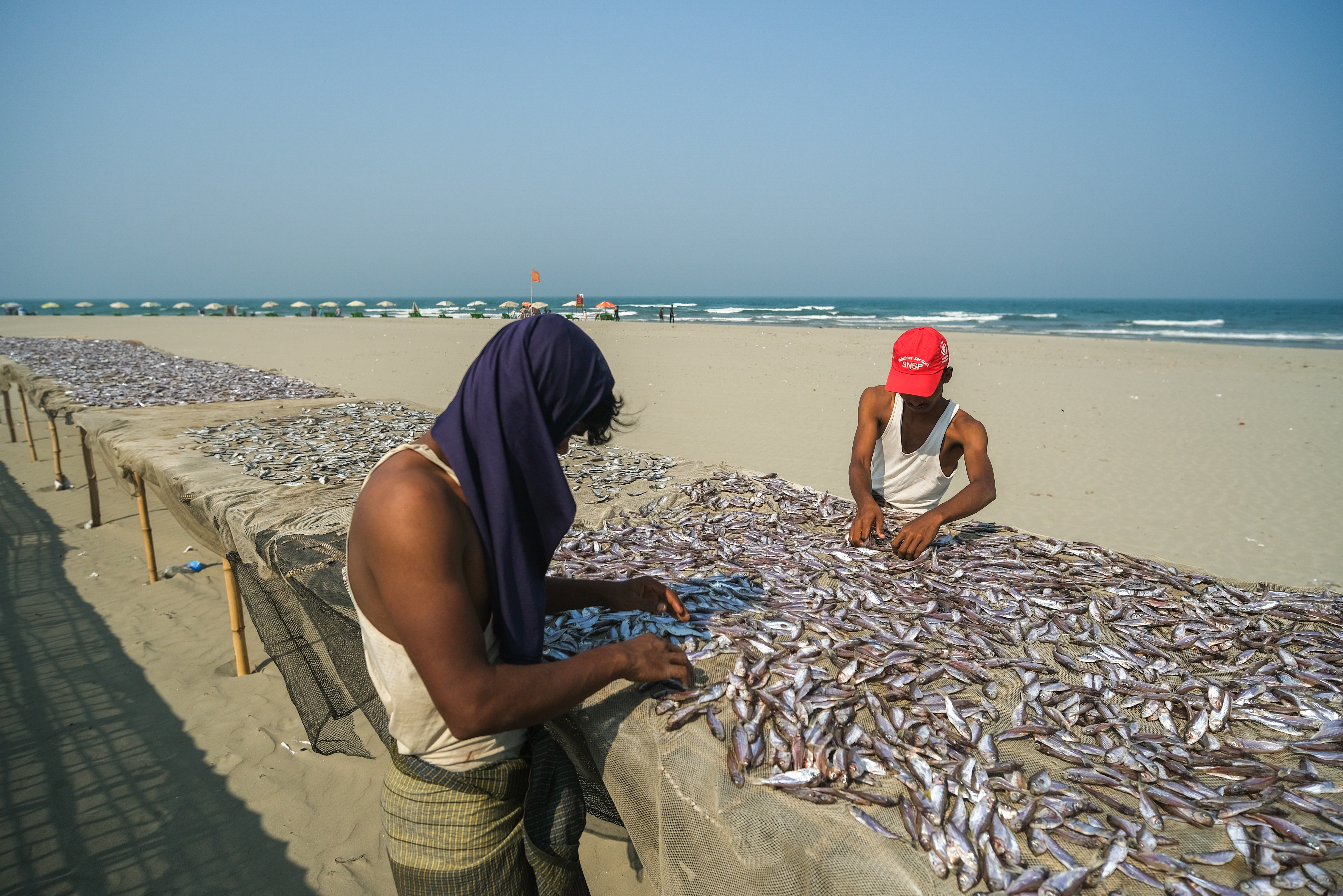
Although many people are now involved in the tourism business, many on the island still make a living by fishing. During winter and spring, numerous dry fish traders sustain themselves by catching fish, drying some of their catch, and selling it throughout the year. Photo by Saqlain Rizve.
Once, fishing in the bay was the main profession for island residents, along with some small businesses like vegetable and grocery shops. Now the scenario has changed thanks to tourism.
“Six months of the year, I ride this rickshaw as the island fills with tourists,” Harun Miah told me while I was riding on his rickshaw during my last tour. “These tourists are wealthy, which is why the fare has increased significantly, allowing me to earn a substantial amount of money. This wasn’t possible even a few years ago. For the next six months, I will fish in the bay.”
I first set foot on Saint Martin’s Island in 2022 and have returned in the two years since. The transformation of the island has been profound since the tourism industry’s expansion in the early 2000s. In recent years, vacant land has become scarce, with resorts and hotels now occupying nearly every available space. The beachfront and central market area, in particular, have experienced a rapid proliferation of hospitality establishments, with an array of resorts, hotels, and restaurants emerging to cater to the growing influx of visitors.
This development has reshaped the island’s landscape, leaving little untouched by the tourism boom.
In the bustling market area, the arrival of seven to ten tourist ships at the jetty ghat has created significant traffic congestion, reminiscent of Dhaka’s notorious jams. The key difference lies in the types of vehicles; while Dhaka’s streets are filled with private cars, motorcycles, CNG-run auto-rickshaws, and buses, here the congestion is solely due to battery-operated auto-rickshaws. These rickshaws are mostly priced at over $1,000 and brought from the capital to Teknaf. Once purchased, they make their way to the island aboard a mid-sized trawler.
“The tourism business has not only changed my fate but also all the islanders’, directly and indirectly,” Nur said.
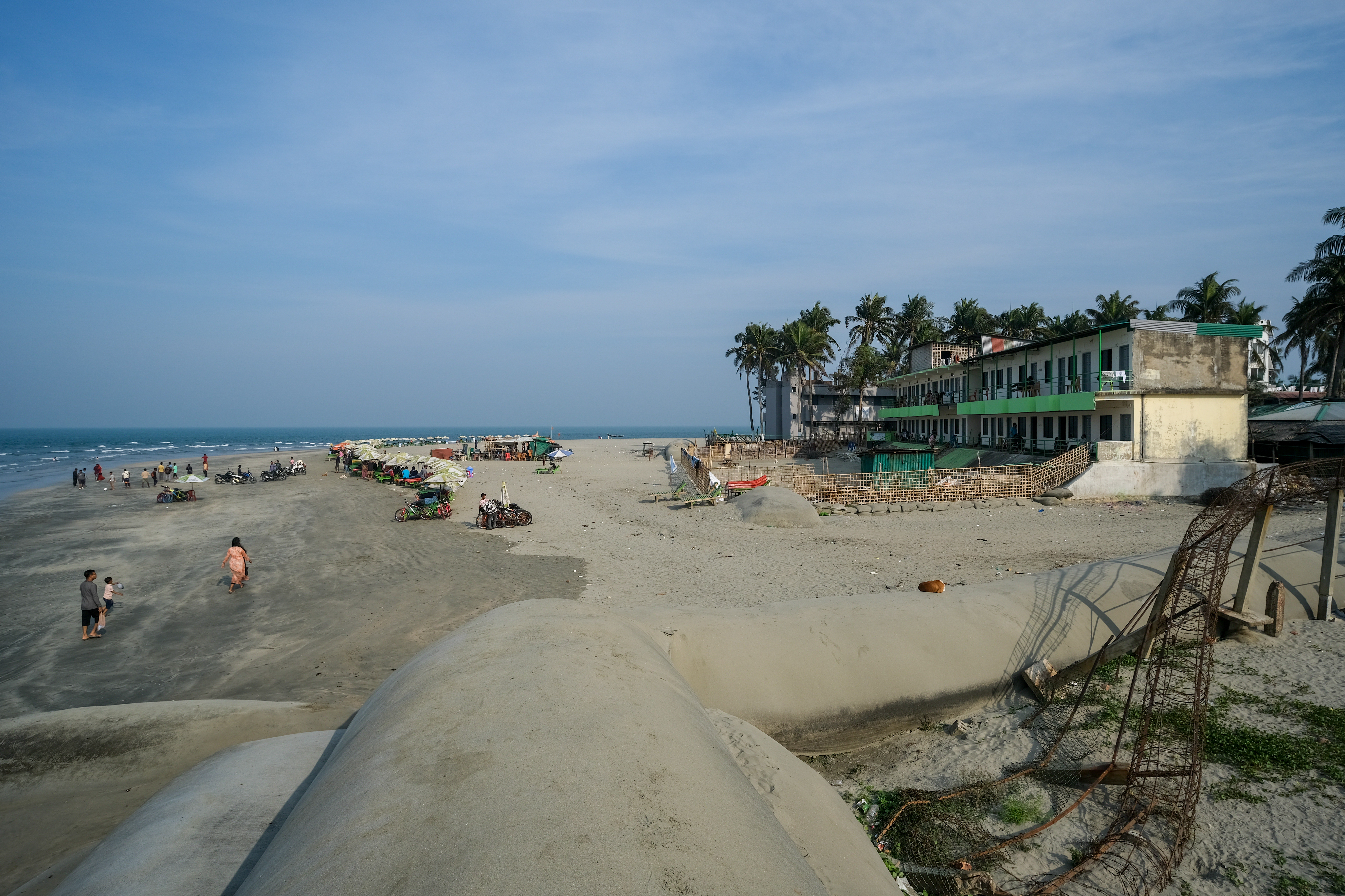
Numerous brick and stone structures have been built across the island and along the beach, primarily catering to tourists. Almost all of these structures are hotels, resorts, or restaurants. Photo by Saqlain Rizve.
On one hand, the tourism boom has boosted Saint Martin’s economy; on the other hand it also caused ecological concerns. Media reports and environmental studies highlight rapid land cover changes, the near-extinction of mangroves, and threats to coral reefs.
According to a recent study, the island may lose all of its coral reefs by 2045.
The Bangladeshi government declared a marine protected area on the island last year and introduced strict guidelines to protect the island’s ecology, including mandatory online tourist registration and fixed travel fees, although not all have yet been implemented.
However, the carefully laid plans to balance economics and environment were thrown awry by the conflict in Myanmar.
This February, due to the dispute along the border, the administration banned the Teknaf-Saint Martin’s route, where tourist ships run regularly. The government later permitted only two ships from Cox’s Bazar, which is a longer journey than the normal route. As a result the tourism business saw massive losses.
“I have a share in a resort here,” said Nur. “We’ve lost at least 70 percent of our revenue compared to previous years, and it seems the next season will also be dull.”
The Bangladesh-Myanmar border remains peaceful most of the time, especially compared to Bangladesh’s border with India, one of the deadliest in the world. However, many times stray bullets fired from Myanmar troops and resistance groups have caus feared among Bangladesh’s civilians.
Reports of bullets fired from Myanmar territory toward Bangladeshi fishing boats have occasionally reached the media, though this year such incidents have become more frequent.
The encroaching violence from Myanmar has become a daily concern for the islanders. Food shortages resulting from being cut off from the mainland have worsened the problem. Bangladesh has not taken a firm stand regarding Myanmar’s conflict, indicating a reluctance to get involved in any fight.
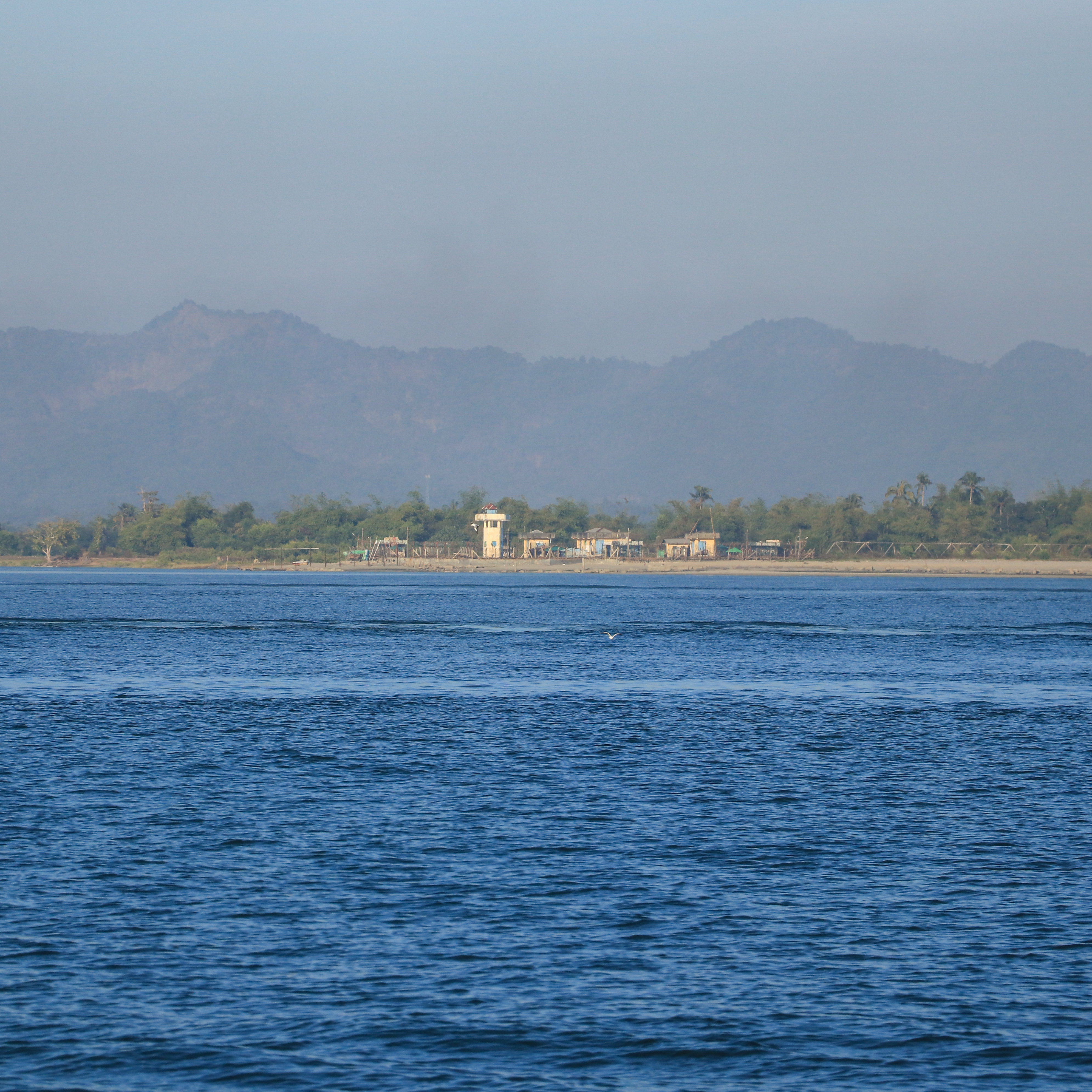
Some buildings in Myanmar territory visible from the Naf River. Photo by Saqlain Rizve.
Obaidul Quader, the general secretary of the Awami League and the minister of road, transport, and bridges, stated on Saturday that efforts are underway to address the issue of Myanmar’s firing on the island through diplomatic discussions. Bangladesh aims to resolve the matter peacefully through dialogue, avoiding conflict, but will respond if attacked, he said.
Back in 2018, Myanmar included Saint Martin’s Island on its official map, suggesting it was attempting to claim the island. The government of the time removed it after diplomatic discussions between the two countries, but that administration has since been ousted by the current junta.
Although there are no major disputes between the countries, diplomatic relations between Bangladesh and Myanmar have not been healthy. A longstanding dispute over their maritime boundary in the Bay of Bengal has persisted since Bangladesh’s independence in 1971. The contention primarily revolved around their overlapping territorial seas, Exclusive Economic Zones (EEZs), and continental shelves, with Saint Martin’s Island near the heart of conflict.
However, in a landmark judgment on March 14, 2012, the International Tribunal for the Law of the Sea (ITLOS) delivered its verdict on the maritime boundary between the two countries. The tribunal had to delimit the territorial sea boundary, the single maritime boundary between the EEZs, and the continental shelves boundary beyond 200 nautical miles from the nation’s respective baselines.
Notably, the 2012 ITLOS judgment affirmed Bangladesh’s sovereignty over the Saint Martin’s Island.
During Bangladesh’s national election period, Saint Martin’s became a focal point of international interest, particularly from the United States and China, due to its strategic location. The U.S. has been rumored to have an interest in using the island to strengthen its presence in the region. Similarly, China’s ambitions may also extend to Saint Martin’s, given its proximity to the Bay of Bengal and the significance of maritime routes for trade and military strategy.
Amid these geopolitical maneuvers, Prime Minister Sheikh Hasina has firmly stated that her government will not compromise the country’s sovereignty or resources for foreign interests.
She responded to speculations by asserting that no national assets, including Saint Martin’s, would be leased out. Hasina even alleged in a press briefing this May that “a white man” offered to smooth her path to reelection in the January 7 polls if she allowed an unnamed foreign country to set up an airbase within Bangladesh. Without specifics, she accused unnamed actors of seeking to “create a Christian country taking a part of Bangladesh and Myanmar forming a base in the Bay of Bengal.”
Hasina said she had rejected the offer, but suggested that the Bangladesh Nationalist Party, the main opposition, “would have done that.”
Amid all the wrangling over Saint Martin’s Island, one thing is clear: If the Bangladesh government doesn’t adopt a strong strategy and take decisive action, it will be the islanders who suffer the most.
“The conflict between the junta and AA is currently centered around Maungdaw, a town in Rakhine State, and is extending into the waterways, particularly the Naf River,” said Altaf Parvez, a researcher and writer on Southeast Asian history and politics.
“Additionally, navigability of the Naf River has been reduced in parts of Bangladesh, forcing many boats and seasonal tourist ships to travel near the Myanmar border, increasing risks,” he added. “The Bangladesh government must maintain good relations with both the AA and Myanmar government, as it seems the AA may soon take control of Rakhine State.”
Shahariar Sadat, deputy executive director of the Center for Peace and Justice at Brac University, emphasized said that “many people are raising questions about whether there is any risk that someone will take control of Saint Martin’s. I don’t think the situation is like that.”
“However, the ongoing conflicts are causing immense suffering for the local population. The government must engage in constructive bilateral discussions and steer clear of entanglement in conflicts. Many parties may attempt to draw Bangladesh into the internal conflict of Myanmar.”
He added, “Conflict never brings any good to a nation. Therefore, patience is crucial, and I trust the government will adopt a robust foreign policy to ensure the safety of islanders while maintaining a positive relationship with Myanmar.”
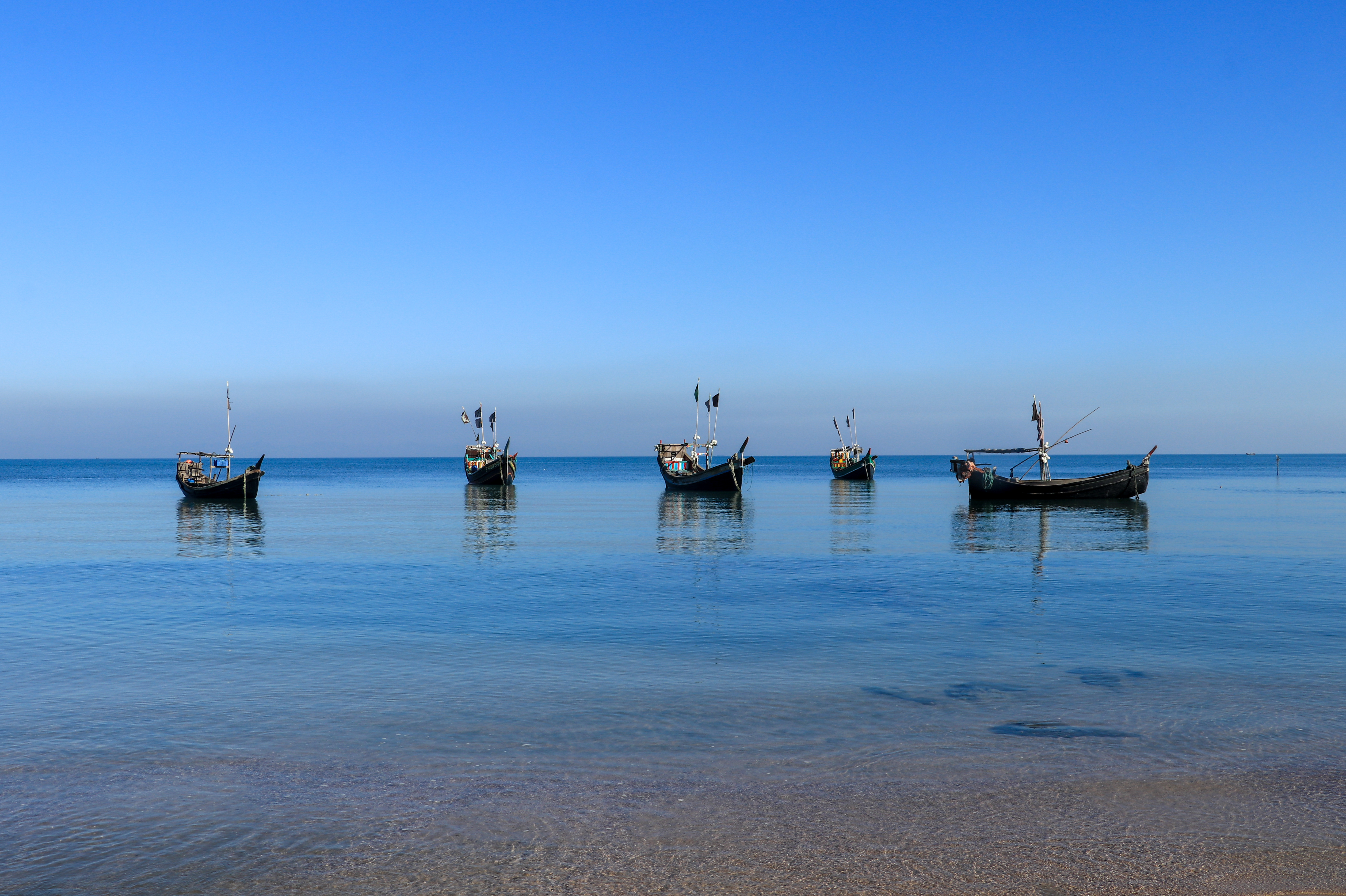
Fishing boats off the eastern beach of Saint Martin’s Island. Photo by Saqlain Rizve.
Along with the current crisis, Myanmar has already placed a huge burden on Bangladesh by forcing more than 1 million Rohingya refugees from Rakhine State across the border, especially in the mass exodus that took place in 2017.
As of 2024, the situation for the Rohingya in Bangladesh remains precarious. The camps in Cox’s Bazar are struggling with overcrowding and limited access to essential service.
Early this month Hasina said the government would not allow new structures in the Rohingya camps in Cox’s Bazar, saying the camps had already caused an “environmental and ecological imbalance… due to massive deforestation.”
Moreover, Home Minister Asaduzzaman Khan said this March that no more Rohingya or Myanmar nationals will be allowed to enter Bangladesh.
The circumstances indicate that Bangladesh will not accept any more Rohingya refugees into its territory.













